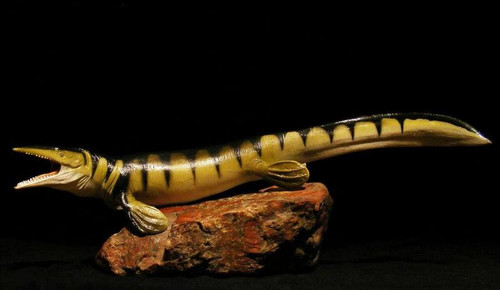A massive mosasaur that snacked on sharks during the age of the dinosaurs.
This massive mosasaur is not a true dinosaur, but a marine reptile that thrived in some of the most dangerous oceans in our planet's history. Tylosaurus received a great deal of media attention after appearing in the BBC documentary "Sea Monsters", where it can be seen hunting sharks effortlessly. This foot-long sculpt is one of the most scientifically accurate reconstructions available, from the sleek, serpentine body shape to the characteristically elongated snout. This replica not only does justice to the animal, but to the magnificent original sculpture by Forest Rogers. The skin is deep green with a white ventral surface, and has an impressive shiny finish that makes the entire animal glisten as though recently emerged from prehistoric waters. Rock base not included.
"...a simply stunning replica... One of the most impressive aspects of this figure is the huge attention to detail in and around the mouth. In overall shape the head is pointed and the slit-like nostrils are retracted. The teeth are individually sculpted, there are palatine teeth on the roof of the mouth and the tongue and gullet are sculpted in great detail too. The very front part of the mouth forms a pointed tip, which extends beyond the teeth – this is an accurate characteristic for Tylosaurus. The species name Tylosaurus proriger even means ’prow-bearing knob lizard’ in reference to this anatomical feature. Safari have clearly been doing their homework, consulting with mosasaur specialist Mike Everhart has given this model a scientific edge. Although mosasaur skin is known to have been scaly, the individual scales were small and so they are not apparent at this 1/40 scale. The skin is therefore smooth and has a beautiful and fitting watery sheen. The animal is countershaded with dark green on the top and paler green and white on the underside. A striking series of deep green stripes run along the length of the body and down the tail. Sculptor Forest Rogers should be congratulated on this piece, which I highly recommend."
-Dr. Adam Stuart Smith, Paleontologist, Plesiosauria.com
This massive mosasaur is not a true dinosaur, but a marine reptile that thrived in some of the most dangerous oceans in our planet's history. Tylosaurus received a great deal of media attention after appearing in the BBC documentary "Sea Monsters", where it can be seen hunting sharks effortlessly. This foot-long sculpt is one of the most scientifically accurate reconstructions available, from the sleek, serpentine body shape to the characteristically elongated snout. This replica not only does justice to the animal, but to the magnificent original sculpture by Forest Rogers. The skin is deep green with a white ventral surface, and has an impressive shiny finish that makes the entire animal glisten as though recently emerged from prehistoric waters. Rock base not included.
"...a simply stunning replica... One of the most impressive aspects of this figure is the huge attention to detail in and around the mouth. In overall shape the head is pointed and the slit-like nostrils are retracted. The teeth are individually sculpted, there are palatine teeth on the roof of the mouth and the tongue and gullet are sculpted in great detail too. The very front part of the mouth forms a pointed tip, which extends beyond the teeth – this is an accurate characteristic for Tylosaurus. The species name Tylosaurus proriger even means ’prow-bearing knob lizard’ in reference to this anatomical feature. Safari have clearly been doing their homework, consulting with mosasaur specialist Mike Everhart has given this model a scientific edge. Although mosasaur skin is known to have been scaly, the individual scales were small and so they are not apparent at this 1/40 scale. The skin is therefore smooth and has a beautiful and fitting watery sheen. The animal is countershaded with dark green on the top and paler green and white on the underside. A striking series of deep green stripes run along the length of the body and down the tail. Sculptor Forest Rogers should be congratulated on this piece, which I highly recommend."
-Dr. Adam Stuart Smith, Paleontologist, Plesiosauria.com


